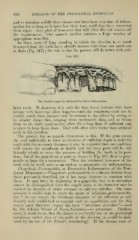Page 958 - My FlipBook
P. 958
968 DISEASES OF THE PERIDENTAL MEMBRANE.
and to stimulate mildly those tissues that have been in a state of inflam-
mation for so long- as to have lost their tone, until they have recovered
their vigor. Any plan of treatment that will effect this will answer all
the requirements. Our materia medica contains a large number of
ap])ropriate remedies.
In those cases of long standing in which the alveolus is so much
destroyed that the teeth have already become very loose not much can
be done (Fig. 517) ; the rule is that the patient will do better with arti-
FiG. 517.
The Alveoli irreparably destroyed by Calcic Inflammation.
ficial teeth. If, however, it is only the four lower incisors that have
become very loose—as often happens—and the remaining teeth can be
readily cured, these incisors may be secured to the others by wiring or
by slender clasps, thus keeping them moderately firm, and so fitting
them to do fairly good service, often for a long time, if sufficient care
is taken to keep them clean. They will often serve better than artificial
teeth in this position.
The general law as regards prognosis is this : If the gum covers
the root sufficiently to form an alveolus of sufficient depth to hold the
tooth with the necessary firmness, it may be expected that care and time
will restore the membrane to health and the bony parts will be suf-
ficiently rebuilt to serve the purpose of holding the tooth in its posi-
tion ; but if the gum-tissue is gone as shown in Fig. 517, there is prac-
tically no hope for a restoration. Then the continual looseness of the
teeth will in itself serve as an irritant to perpetuate the inflammation.
Pliacjcdcnlc Pcv'wementitiH, or Destructive Inflammation of the Peri-
dental INIembrane.—Phagedenic pericementitis is a disease distinct from
those previously described, yet it has many features in common with
them. It may have its beginning in a gingivitis that in its inception
cannot be distinguished from the simple form, or its character may be
masked by deposits of either serumal or salivary calculus. On some
accounts it would seem to merit the name of infectious pericementitis,
but I do not regard the infectious character of the affection as suf-
ficiently well established to warrant such an appellation, and for this
reason must therefore regard the term " infectious alveolitis "—used
by Dr. Adolph Witzel of Essen, Germany—as premature. Further-
more, it seems to me that the disease is essentially one of the peridental
membrane rather than of the walls of the alveolus, as would be indi-
cated by the use of Dr. Witzel's terminology. If the disease were of


